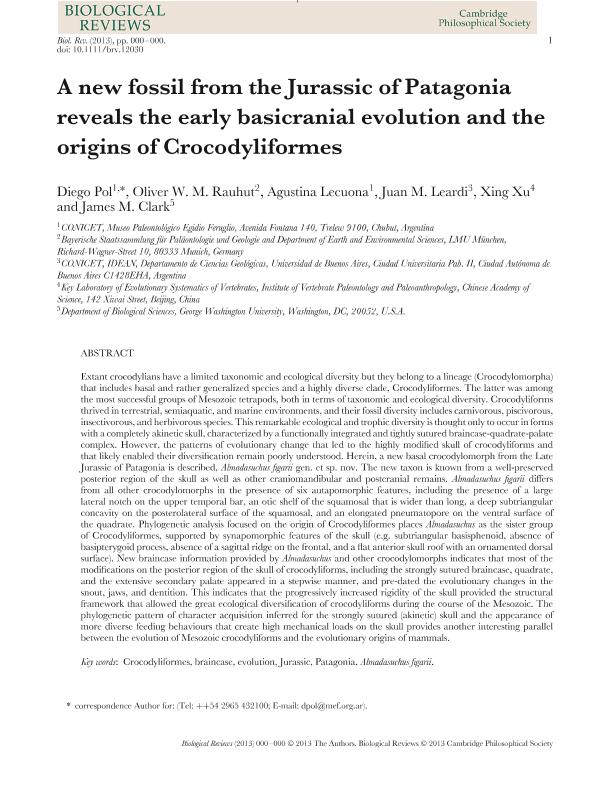Mostrar el registro sencillo del ítem
dc.contributor.author
Pol, Diego

dc.contributor.author
Rauhut, Oliver W. M.
dc.contributor.author
Lecuona, Agustina

dc.contributor.author
Leardi, Juan Martín

dc.contributor.author
Xu, Xing
dc.contributor.author
Clark, James M.
dc.date.available
2016-09-07T19:31:36Z
dc.date.issued
2013-10
dc.identifier.citation
Pol, Diego; Rauhut, Oliver W. M.; Lecuona, Agustina; Leardi, Juan Martín; Xu, Xing ; et al.; A new fossil from the Jurassic of Patagonia reveals the early basicranial evolution and the origins of Crocodyliformes; Wiley; Biological Reviews; 88; 4; 10-2013; 862-872
dc.identifier.issn
1464-7931
dc.identifier.uri
http://hdl.handle.net/11336/7536
dc.description.abstract
Extant crocodylians have a limited taxonomic and ecological diversity but they belong to a lineage (Crocodylomorpha) that includes basal and rather generalized species and a highly diverse clade, Crocodyliformes. The latter was among the most successful groups of Mesozoic tetrapods, both in terms of taxonomic and ecological diversity. Crocodyliforms thrived in terrestrial, semiaquatic, and marine environments, and their fossil diversity includes carnivorous, piscivorous, insectivorous, and herbivorous species. This remarkable ecological and trophic diversity is thought only to occur in forms with a completely akinetic skull, characterized by a functionally integrated and tightly sutured braincase-quadrate-palate complex. However, the patterns of evolutionary change that led to the highly modified skull of crocodyliforms and that likely enabled their diversification remain poorly understood. Herein, a new basal crocodylomorph from the Late Jurassic of Patagonia is described, Almadasuchus figarii gen. et sp. nov. The new taxon is known from a well-preserved posterior region of the skull as well as other craniomandibular and postcranial remains. Almadasuchus figarii differs from all other crocodylomorphs in the presence of six autapomorphic features, including the presence of a large lateral notch on the upper temporal bar, an otic shelf of the squamosal that is wider than long, a deep subtriangular concavity on the posterolateral surface of the squamosal, and an elongated pneumatopore on the ventral surface of the quadrate. Phylogenetic analysis focused on the origin of Crocodyliformes places Almadasuchus as the sister group of Crocodyliformes, supported by synapomorphic features of the skull (e.g. subtriangular basisphenoid, absence of basipterygoid process, absence of a sagittal ridge on the frontal, and a flat anterior skull roof with an ornamented dorsal surface). New braincase information provided by Almadasuchus and other crocodylomorphs indicates that most of the modifications on the posterior region of the skull of crocodyliforms, including the strongly sutured braincase, quadrate, and the extensive secondary palate appeared in a stepwise manner, and pre-dated the evolutionary changes in the snout, jaws, and dentition. This indicates that the progressively increased rigidity of the skull provided the structural framework that allowed the great ecological diversification of crocodyliforms during the course of the Mesozoic. The phylogenetic pattern of character acquisition inferred for the strongly sutured (akinetic) skull and the appearance of more diverse feeding behaviours that create high mechanical loads on the skull provides another interesting parallel between the evolution of Mesozoic crocodyliforms and the evolutionary origins of mammals.
dc.format
application/pdf
dc.language.iso
eng
dc.publisher
Wiley

dc.rights
info:eu-repo/semantics/openAccess
dc.rights.uri
https://creativecommons.org/licenses/by-nc-sa/2.5/ar/
dc.subject
Crocodyliformes
dc.subject
Braincase
dc.subject
Evolution
dc.subject
Jurassic
dc.subject
Patagonia
dc.subject
Almadasuchus Figarii
dc.subject.classification
Paleontología

dc.subject.classification
Ciencias de la Tierra y relacionadas con el Medio Ambiente

dc.subject.classification
CIENCIAS NATURALES Y EXACTAS

dc.title
A new fossil from the Jurassic of Patagonia reveals the early basicranial evolution and the origins of Crocodyliformes
dc.type
info:eu-repo/semantics/article
dc.type
info:ar-repo/semantics/artículo
dc.type
info:eu-repo/semantics/publishedVersion
dc.date.updated
2016-09-05T13:22:19Z
dc.journal.volume
88
dc.journal.number
4
dc.journal.pagination
862-872
dc.journal.pais
Reino Unido

dc.journal.ciudad
Londres
dc.description.fil
Fil: Pol, Diego. Museo Paleontológico Egidio Feruglio; Argentina. Consejo Nacional de Investigaciones Científicas y Técnicas; Argentina
dc.description.fil
Fil: Rauhut, Oliver W. M.. Bayerische Staatssammlung Fur Palaontologie Und Geologie; Alemania
dc.description.fil
Fil: Lecuona, Agustina. Museo Paleontológico Egidio Feruglio; Argentina. Consejo Nacional de Investigaciones Científicas y Técnicas; Argentina
dc.description.fil
Fil: Leardi, Juan Martín. Consejo Nacional de Investigaciones Científicas y Técnicas. Oficina de Coordinación Administrativa Ciudad Universitaria. Instituto de Estudios Andinos; Argentina. Universidad de Buenos Aires; Argentina
dc.description.fil
Fil: Xu, Xing . Chinese Academy of Science. Institute of Vertebrate Paleontology and Paleoanthropology; China
dc.description.fil
Fil: Clark, James M.. George Washington University; Estados Unidos
dc.journal.title
Biological Reviews

dc.relation.alternativeid
info:eu-repo/semantics/altIdentifier/doi/http://dx.doi.org/10.1111/brv.12030
dc.relation.alternativeid
info:eu-repo/semantics/altIdentifier/url/http://onlinelibrary.wiley.com/doi/10.1111/brv.12030/abstract
Archivos asociados
